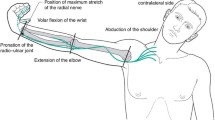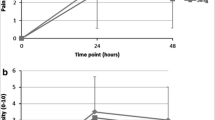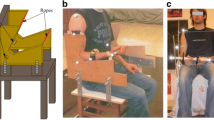Abstract
The effects of muscle pain on movement can easily be observed in daily life routines. However, the influence of muscle pain on motor control strategies has not been fully clarified. In this human experimental study it was hypothesized that muscle pain affects the motor control of elbow flexion movements, in different combinations of range of motion and target size, by decreased agonistic muscle activity and increased antagonistic muscle activity with consequent implications on kinematic parameters. The effects of experimentally induced muscle pain on movement strategy for: (1) small and large range of motion (ROM) elbow flexion movements towards a wide target, (2) large ROM flexion movements towards a narrow and wide target, and (3) subsequent coactivation of agonistic and antagonistic muscles to elbow flexion were assessed. Muscle pain induced by injections of hypertonic saline (1 ml, 5.8%) in either m. biceps brachii or m. triceps brachii caused similar effects on the movements. For low accurate movements the initial (100 ms) integrated electromyographic (EMG) activity of m. biceps brachii was decreased during muscle pain. In contrast, integrated EMG of the entire m. biceps brachii burst was decreased by muscle pain only for small ROM at a low accuracy, which also showed decreased EMG activity of m. triceps brachii and m. brachioradialis, together with increased activity of m. trapezius. Finally, high accurate movements and post-movement coactivation were generally not modulated by muscle pain. In summary, the present study shows that acute muscle pain can perturb the motor control strategy, which might be highly important in occupational settings where such a change may need compensatory actions from other muscles and thereby eventually contribute to the development of musculoskeletal pain problems.





Similar content being viewed by others
References
Arendt-Nielsen L, Graven-Nielsen T, Svanner H, Svensson P (1996) The influence of low back pain on muscle activity and coordination during gait: a clinical and experimental study. Pain 64:231–240
Ashton-Miller JA, McGlashen KM, Herzenberg JE, Stohler CS (1990) Cervical muscle myoelectric response to acute experimental sternocleidomastoid pain. Spine 15:1006–1012
Backman E, Bengtsson A, Bengtsson M, Lennmarken C, Henriksson KG (1988) Skeletal muscle function in primary fibromialgia: effect of regional sympathetic blockade with guanethidine. Acta Neurol Scand 77:187–191
Birch L, Graven-Nielsen T, Christensen H, Arendt-Nielsen L (2000) Experimental muscle pain modulates muscle activity and work performance differently during high and low precision use of a computer mouse. Eur J Appl Physiol 83:492–498
Birch, L, Arendt-Nielsen L, Graven-Nielsen T, Christensen H (2001) An investigation of how acute muscle pain modulates performance during computer work with digitizer and puck. Appl Ergon 32:281–286
Corcos DM, Gottlieb GL, Agarwal GC (1989) Organizing principles for single-joint movements II. A speed-sensitive strategy. J Neurophysiol 62:358–368
Gottlieb GL, Corcos DM, Agarwal GC (1989) Organizing principles for single-joint movements I. A speed-insensitive strategy. J Neurophysiol 62:342–247
Graven-Nielsen T, Svensson P, Arendt-Nielsen L (1997) Effects of experimental muscle pain on muscle activity and co-ordination during static and dynamic motor function. Electroencephalogr Clin Neurophysiol 105:156–164
Graven-Nielsen T, Lund H, Arendt-Nielsen L, Danneskiold-Samsøe B, Bliddal H (2002) Inhibition of maximal voluntary contraction force by experimental muscle pain: a centrally mediated mechanism. Muscle Nerve 26:708–712
Gribble PL, Ostry DJ (1998) Independent coactivation of shoulder and elbow muscles. Exp Brain Res 123:355–360
Hammond MC, Fitts SS, Kraft GH, Nutter PB, Trotte MJ, Robinson LM (1988) Co-contraction in the hemiparetic forearm: quantitative EMG evaluation. Arch Phys Med Rehabil 69:348–351
Larsson B, Bjork J, Elert J, Gerdle B (2000) Mechanical performance and electromyography during repeated maximal isokinetic shoulder forward flexions in female cleaners with and without myalgia of the trapezius muscle and in healthy controls. Eur J Appl Physiol 83:257–267
Le Pera D, Graven-Nielsen T, Valeriani M, Oliviero A, Di Lazzaro V, Tonali PA, Arendt-Nielsen L (2001) Inhibition of motor system excitability at cortical and spinal level by tonic muscle pain. Clin Neurophysiol 112:1633–1641
Lund JP, Donga R, Widner CG, Stohler CS (1991) The pain-adaptation model: a discussion of the relationship between chronic musculoskeletal pain and motor activity. Can J Physiol Pharmacol 69:683–694
Madeleine P, Lundager B, Voigt M, Arendt-Nielsen L (1999a) Shoulder muscle co-ordination during chronic and acute experimental neck-shoulder pain: an occupational pain study. Eur J Appl Physiol 79:127–140
Madeleine P, Voigt M, Arendt-Nielsen L (1999b) Reorganization of human step initiation during acute experimental muscle pain. Gait Posture 10:240–247
Matre DA, Sinkjaer T, Svensson P, Arendt-Nielsen L (1998) Experimental muscle pain increases the human stretch reflex. Pain 75:331–339
Matthews G, Dorn L (1989) IQ and choice reaction time: an information processing analysis. Intelligence 13:299–317
Ro JY, Capra NF (2001) Modulation of jaw muscle spindle afferent activity following intramuscular injections with hypertonic saline. Pain 92:117–127
Suzuki N, Endo S (1983) A quantitative study of trunk muscle strength and fatigability in the low-back-pain syndrome. Spine 8:69–74
Svensson P, Graven-Nielsen T, Matre D, Arendt-Nielsen L (1998) Experimental muscle pain does not cause long-lasting increases in resting electromyographic activity. Muscle Nerve 21:1382–1389
Svensson P, McMillan AS, Graven-Nielsen T, Wang Kelun, Arendt-Nielsen L (1999) Modulation of an inhibitory reflex in single motor units in human masseter by tonic painful stimulation. Pain 83:441–446
Taimala S, Kujala UM (1992) Reaction times with reference to musculoskeletal complaints in adolescence. Percept Motor Skills 75:1075–1082
Veiersted KB, Westgaard Rh, Andersen P (1990) Pattern of muscle activity during stereotyped work and its relation to muscle pain. Int Arch Occup Environ Health 62:31–41
Wang K, Arendt-Nielsen L, Svensson P (2002) Capsaicin-induced muscle pain alters the excitability of the human jaw-stretch reflex. J Dent Res 81:650–654
Westgaard Rh, Vasseljen O, Holte KA (2001) Trapezius muscle activity as a risk indicator for shoulder and neck pain in female service workers with low biomechanical exposure. Ergonomics 44:339–353
Zedka M, Prochazka A, Knight B, Gillard D, Gauthier M (1999) Voluntary and reflex control of human back muscles during induced pain. J Physiol 520:591–604
Acknowledgements
The Danish Technical Research Council has supported this work. CNPq/Brazil provided a scholarship for U.F. Ervilha.
Author information
Authors and Affiliations
Corresponding author
Rights and permissions
About this article
Cite this article
Ervilha, U.F., Arendt-Nielsen, L., Duarte, M. et al. The effect of muscle pain on elbow flexion and coactivation tasks. Exp Brain Res 156, 174–182 (2004). https://doi.org/10.1007/s00221-003-1781-1
Received:
Accepted:
Published:
Issue Date:
DOI: https://doi.org/10.1007/s00221-003-1781-1




